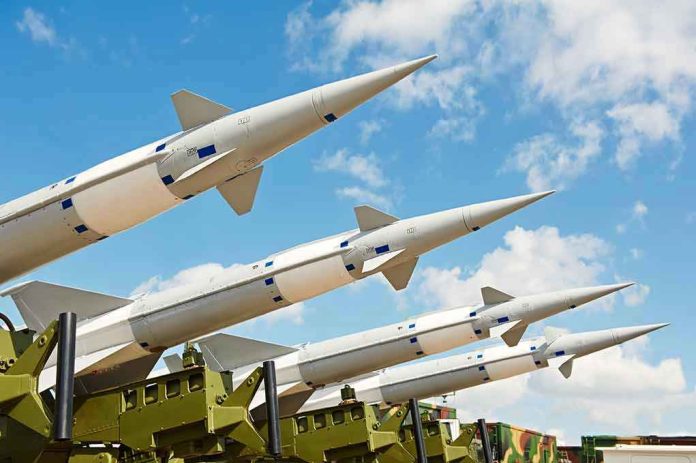
America’s ability to defend itself in a major war is threatened by a critical shortage of weapons and munitions, exposing years of misguided priorities and bureaucratic neglect.
Story Snapshot
- America’s defense industry faces a severe munitions shortfall, risking readiness against threats like China.
- Decades of underinvestment, supply chain fragility, and global commitments have strained military stockpiles.
- Efforts to ramp up production are hampered by workforce shortages and industry consolidation.
- Industry workers and experts warn urgent reforms are needed to restore American military strength.
Post-Cold War Downsizing Created Today’s Weapon Shortage
After the Cold War, U.S. leadership downsized the defense industrial base, shuttering production lines and consolidating suppliers under the false belief that large-scale wars were a thing of the past. This led to a focus on high-tech, low-volume systems, sidelining mass production of basic munitions. As a result, today’s arsenal lacks the capacity for sustained, high-intensity conflict against peer adversaries, despite the world’s largest defense budget. This fragile industrial consolidation has left America vulnerable to supply shocks and bottlenecks, especially as global threats rise.
Military interventions in the Middle East during the 1990s and 2010s did not require vast munitions inventories. However, Russia’s annexation of Crimea in 2014 and the Ukraine war starting in 2022 forced the U.S. to send massive quantities of weapons overseas, rapidly depleting stockpiles. Simultaneous support for Israel and other allies further strained resources. Now, tensions with China, particularly over Taiwan, have exposed the real risk: running out of critical munitions if a major conflict erupts. Audits and reports have warned about these shortfalls, but bureaucratic inertia and lack of sustained investment have allowed the problem to worsen.
Industry Bottlenecks and Workforce Shortages Hamper Recovery
Defense production is now dominated by a handful of prime contractors, giving them leverage over pricing and production schedules. While Congress controls budgets and procurement reforms, industry workers—engineers, machinists, and technicians—are on the front lines, struggling with outdated facilities and a shrinking, aging workforce. The Department of Defense’s attempts to modernize and expand production face long lead times and persistent bottlenecks. New “Munitions War Rooms” and multi-year procurement contracts have been established to incentivize investment, but actual output remains far below what national security demands.
Prime contractors, such as Lockheed Martin and Raytheon, are investing in new facilities, yet expansion is slow. Delays in shipbuilding and maintenance have reached months or even years, further eroding readiness. The industrial base’s limited surge capacity is a major concern, especially when adversaries are rapidly expanding their own arsenals. Congressional defense committees and senior DoD officials acknowledge the challenge but struggle to enact reforms swiftly enough to restore confidence in America’s military capabilities.
National Security and Economic Risks Grow Amid Political Debate
The Pentagon has recently paused or slowed some weapons transfers to Ukraine to preserve U.S. inventories, highlighting the severity of the shortfall. Experts warn that without major reforms, America risks losing its technological and industrial edge, undermining both deterrence and the confidence of allies who rely on U.S. support. The potential for job growth in defense manufacturing exists if production ramps up, but only if workforce development and supply chain resilience are prioritized.
Political debates over defense spending and industrial policy have intensified. Some experts advocate greater burden-sharing with allies and diversification of supply chains, while others stress the need for technological innovation and new management software. The consensus is clear: the current situation is unsustainable and demands urgent action. For America’s military personnel, defense workers, and communities dependent on these contracts, the stakes could not be higher. The risk of eroding public confidence in America’s readiness and ability to defend itself grows unless leaders act decisively to fix systemic problems and restore the nation’s arsenal.
Expert Calls for Urgent Reform and Industry Innovation
Industry analysts and think tanks, including the Heritage Foundation, urge the appointment of a “Munitions Tsar” to coordinate and accelerate production. The Army Science Board notes that the U.S. cannot replace munitions fast enough for a major war, echoing the concerns of frontline workers. The Foreign Policy Research Institute highlights a dangerous industrial shortfall and advocates for a new approach to scaling up production. While viewpoints differ on the best solutions, there is broad agreement across government, industry, and independent analysts that America’s defense readiness is at risk unless longstanding obstacles are overcome. Restoration of the “arsenal of democracy” spirit—rapid, large-scale production driven by American ingenuity and hard work—is needed to safeguard U.S. security and freedom.
Sources:
Izvestia analysis: There is a shortage of weapons in the United States – analysis
The Week: Pentagon is missing missiles for a major war
Heritage Foundation: The US military faces a critical missile gap against China
DefenseScoop: Fixing munitions shortages demands better hardware, new software
Foreign Policy Research Institute: America’s Scale Problem





